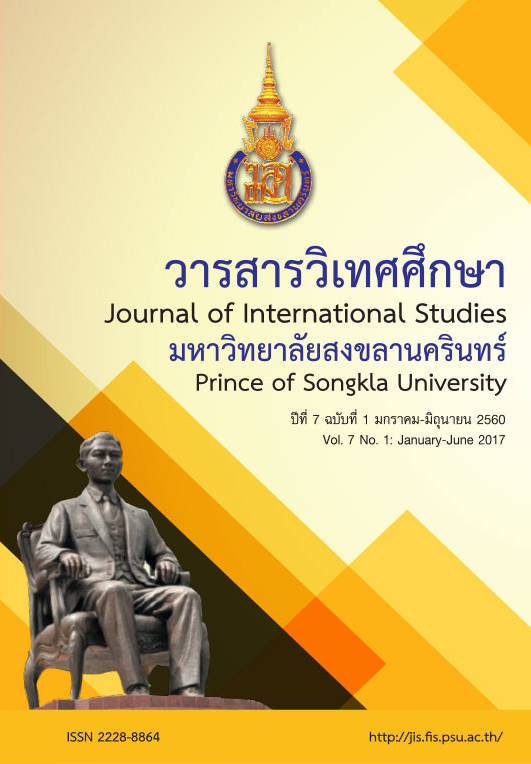Factors Influencing Effectiveness of Interdepartmental Communication in Hospitality Industry: A case Study of 4-5 Star Hotel Employees in Phuket
Main Article Content
Abstract
This study aims to examine the key factors influencing interdepartmental communication in the hospitality industry in Phuket. It specifically seeks to test and evaluate a theoretical framework which consists of certain HR practices affecting the improvement of interdepartmental communication, which the literature review shows. The target population was full time 4-5 star hotel employees in Phuket. The author distributed 600 questionnaires and received 441 in representing a usability response rate of 73.5%. The results showed that four dimensions of HR practices (team work, training, core values and personal development) exerted positive correlation with the interdepartmental communication. Hotels should focus on and maintain a positive organizational culture, provide more training for skills development of their staff and build-up teamwork atmosphere to ensure that their employees can work together with a higher level of interdepartmental communication.
Article Details
Statements and opinions expressed in articles herein are those of the authors and do not necessarily reflect the position of the editors or publisher.
Article, information, text, image, etc. which are published in Journal of International Studies, belong to Journal of International Studies. If anybody or any organization would like to use part or whole of them, they must receive written permission from Journal of International Studies before usage.
References
Agarwal, D., & Garg, A. (2012). The importance of communication within organizations: A research on two hotels in Uttarakhand. IOSR Journal of Business and Management (IOSRJBM), 3(2), 40-49.
Alleyne, P., Doherty, L. &Greenidge, D. (2006). Approaches to HRM in the Barbados hotel industry. International Journal of Contemporary Hospitality Management,18(2), 94-109.
Ballard, D., &Seibold, D. (2006). The experience of time at work: Relationship to communication load, job satisfaction, and interdepartmental communication. Communication Studies,57(3), 317-340.
Bardi, J. (2006). Hotel front office management (4th ed.). Pennsylvania: John Wiley & Sons.
Blomme, R., Sok, J. & Tromp, D. (2013). The influence of organizational culture on negative work-home interference among highly educated employees in the hospitality industry. Journal of Quality Assurance in Hospitality & Tourism,14(1), 1-23.
Cerovic, Z., &Tomasevic, A. (2009). Cognitive and symbolic elements of the organizational culture in hotels. ActaTuristica,21(1), 45-71.
Chen, W., & Cheng, H. (2012). Factors affecting the knowledge sharing attitude of hotel service personnel. International Journal of Hospitality Management, 31, 468-476.
Cooke, F., & Saini, D. (2010). Diversity management in India: A study of organizations in different ownership forms and industrial sectors. Human Resource Management, 49(3), 477-500.
Cumberland, D., & Herd, A. (2011). Organizational culture: Validating a five windows qualitative cultural assessment tool with a small franchise restaurant case study. Organization Development Journal,29(4), 9-20.
Davidson, M., McPhail, R. & Barry, S. (2011). Hospitality HRM: Past, present and the future. International Journal of Contemporary Hospitality Management, 23(4), 498-516.
Dawson, M., & Abbott, J. (2011). Hospitality culture and climate: A proposed model for retaining employees and creating competitive advantage. International Journal of Hospitality & Tourism Administration,12, 289-304.
Gondal, U.H., &Shahbaz, M. (2012). Interdepartmental communication increases organizational performance keeping HRM as a mediating variable. Journal of Asian Business Strategy, 2(6), 127-141.
Hu, M., Ou, T., Chiou, H. & Lin, L. (2012). Effects of social exchange and trust on knowledge sharing and service innovation. Social Behavior and Personality, 40(5), 783-800.
Ilies, L., &Gavrea, C. (2008). The link between organizational culture and corporate performance - an overview. Management and Marketing, 4, 322-325.
Ingram, H., &Desombre, T. (1999) Teamwork: Comparing academic and practitioners’ perceptions.Team Performance Management: An International Journal, 5 (1), 16 - 22.
Katcher, B. (2015). Improving the workplace. How to improve interdepartmental communication. Retrieved March 6, 2015, from http://www.discoverysurveys.com/articles/itw-017.html
Lindholm, N. (1999-2000). National culture and performance management in MNC subsidiaries. International Studies of Management & Organization, 29(4), 45-66.
Lu, C., & Lin, C. (2014). The effects of ethical leadership and ethical climate on employee ethical behavior in the international port context. Journal of Business Ethics,124, 209-223.
Manohar, S., & Pandit, S. (2014). Core values and benefits: A study of leading innovative organizations. Journal of Business Ethics, 125, 667-680.
Molineux, J. (2013). Enabling organizational cultural change using systemic strategic human resource management – A longitudinal case study. The International Journal of Human Resource Management,24(8), 1588-1612.
Nebel, E., Rutherford, D. & Schaffer, J. (1994). Reengineering the hotel organization. Cornell Hotel and Restaurant Administration Quarterly,35(5), 88-95.
Nestoroska, I., &Petrovska, I. (2014). Staff training in hospitality sector as benefit for improved service quality (Scientific paper). University of Rijeka, Croatia.
Paraskevas, A. (2001). Internal service encounters in hotels: An empirical study. International Journal of Contemporary Hospitality Management, 13(6), 285-292.
Rahimi, R. (2014). Organizational culture perspective and implementing customer relationship management (CRM) in hotel industry: Case of a chain hotel in the UK. European Journal of Tourism Research,8, 162-165.
Seiler, J. (1963). Diagnosing interdepartmental conflict.Harvard Business Review, Harvard Business School Publ. Corp, 41, 121-132.
Siano, A., Vollero, A., Confetto, M. &Siglioccolo, M. (2013). Corporate communication management: A framework based on decision-making with reference to communication resources. Journal of Marketing Communications,19(3), 151-167.
Sinclair, M., & Sinclair, C. (2009). Improving hotel efficiency through integration of service and project management cultures. International Journal of Hospitality & Tourism Administration, 10, 344-360.
Thompson, S. (n.d.). Differences between interdepartmental & intradepartmental. Retrieved June 7, 2015, from
http://yourbusiness.azcentral.com/differences-betweeninterdepartmental-intradepartmental-21179.html
Tsaur, S., & Lin, Y. (2004). Promoting service quality in tourist hotels: The role of HRM practices and service behavior. Tourism Management,25, 471-481.
Yang, J. (2009). Individual attitudes to learning and sharing individual knowledge in the hospitality industry. The Service Industries Journal,29(12), 1723-1743.
Zeglat, D., Aljaber, M. &Alrawabdeh, W. (2014). Understanding then impact of employee empowerment on customer-oriented behavior. Journal of Business Studies Quarterly,6(1), 55-67.
Zeithaml, V., Berry, L. & Parasuraman, A. (1988). Communication and control processes in the delivery of service quality. Journal of Marketing,52, 35-48.


